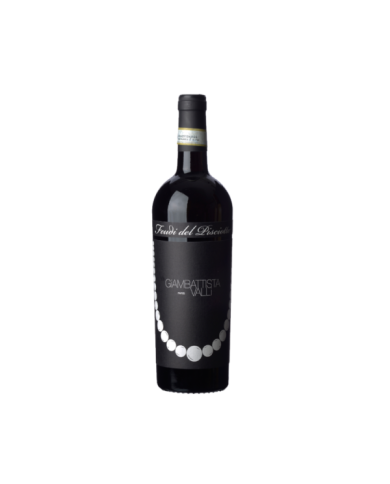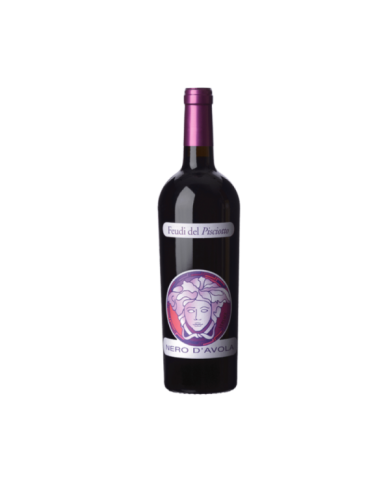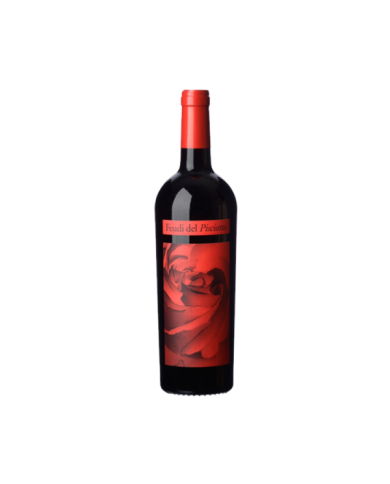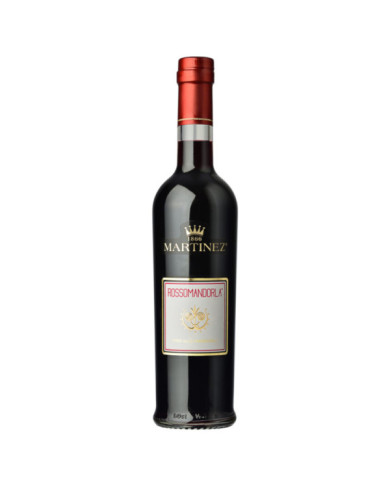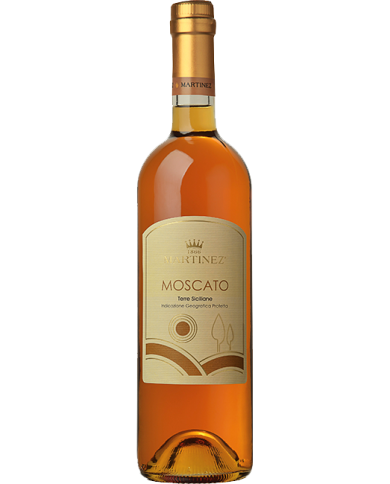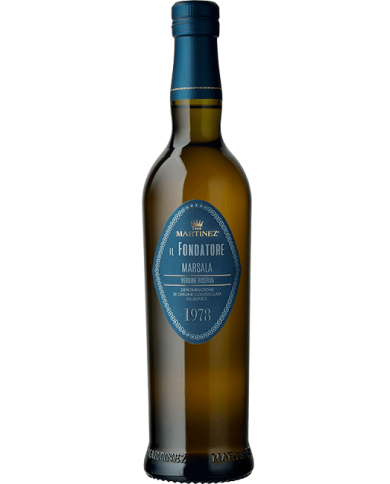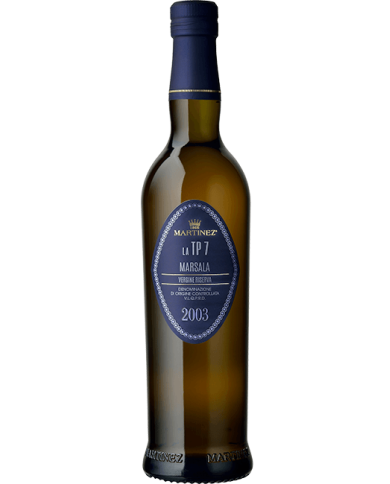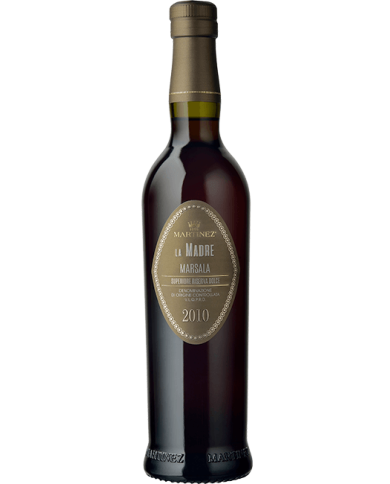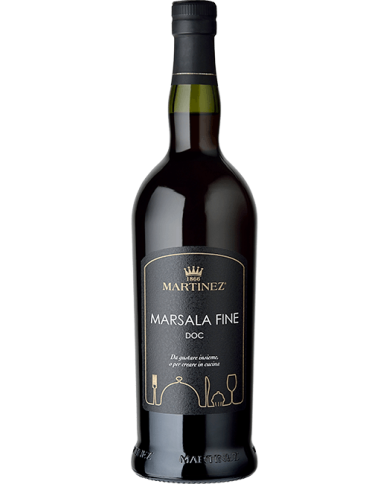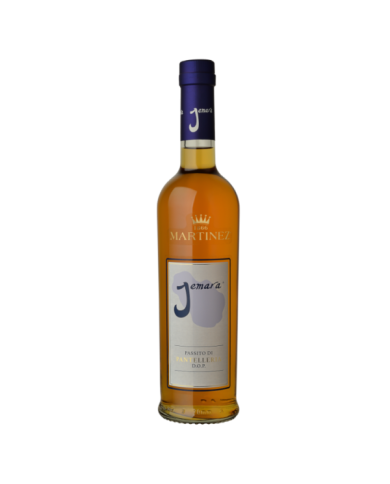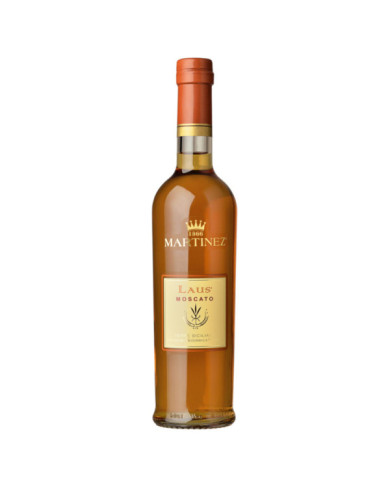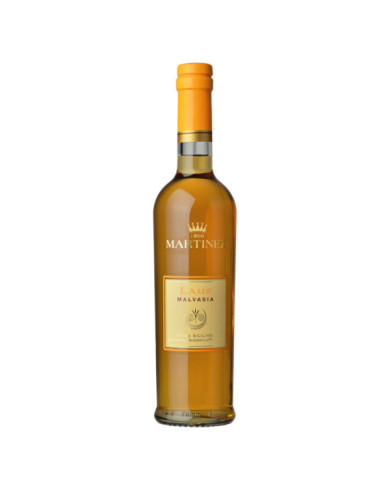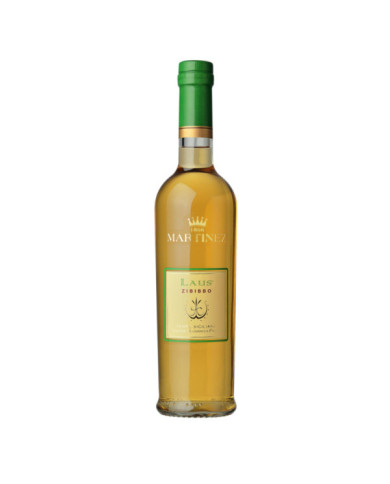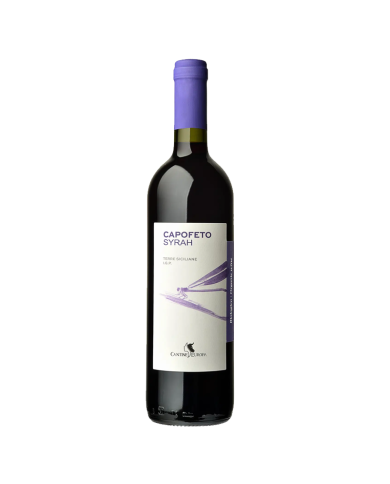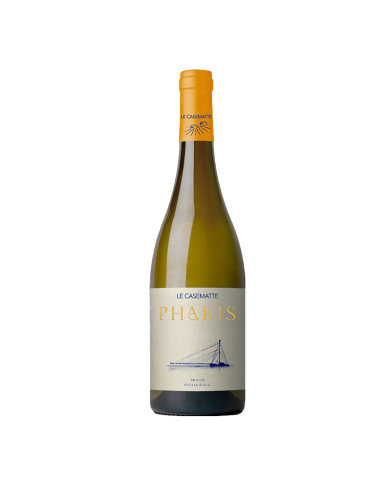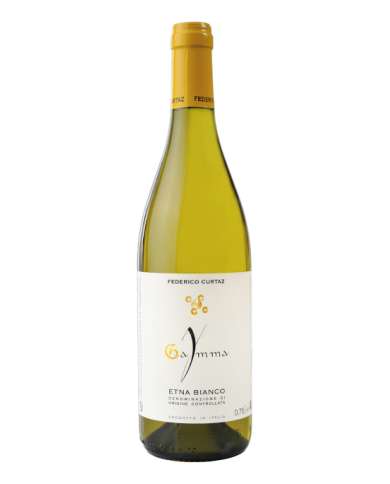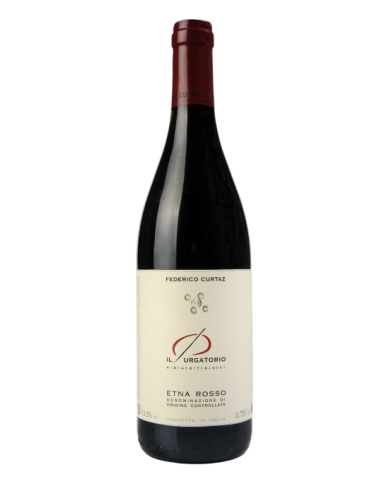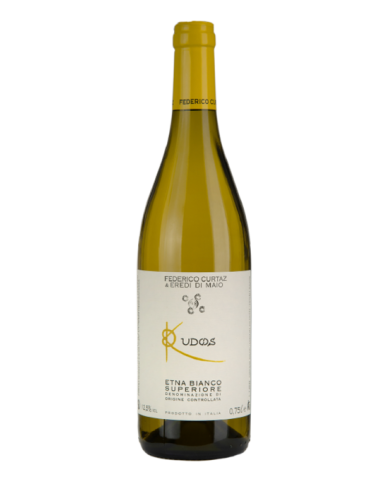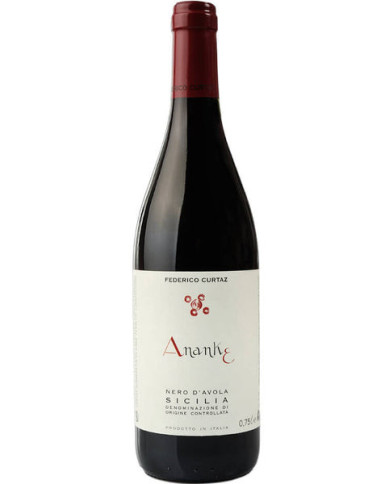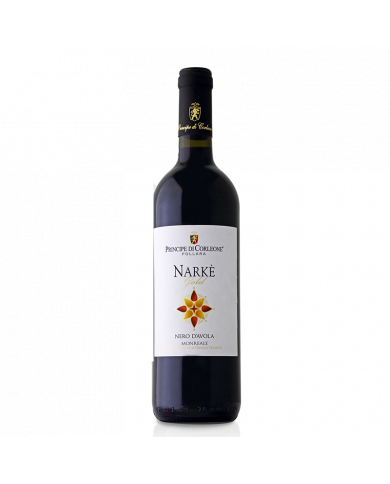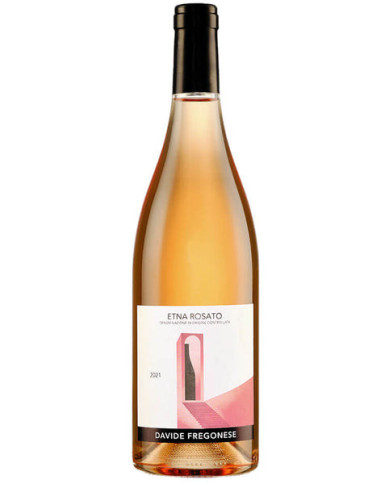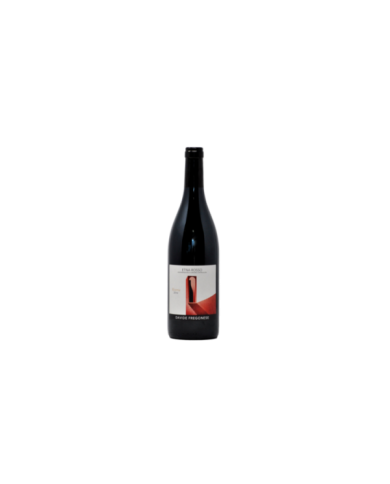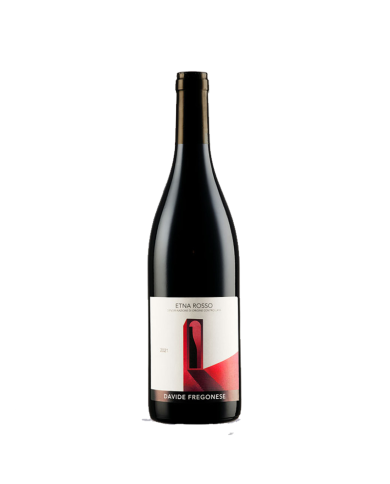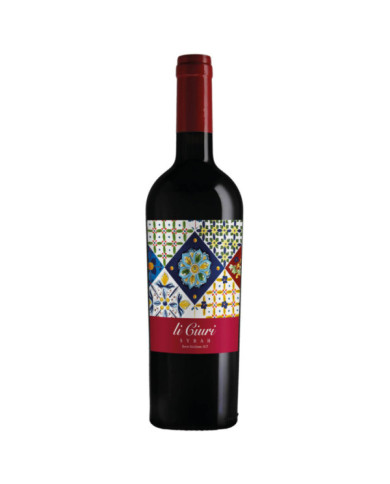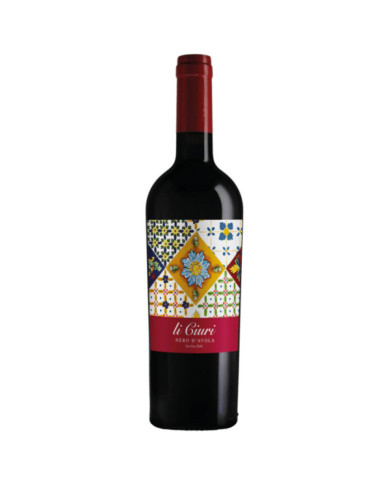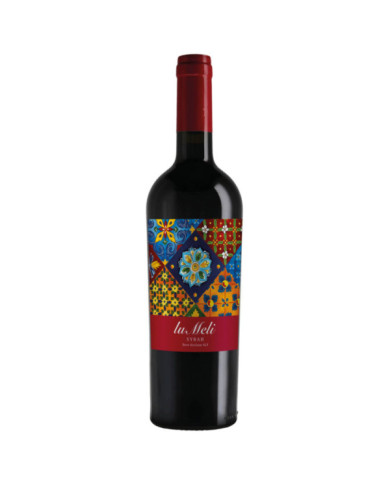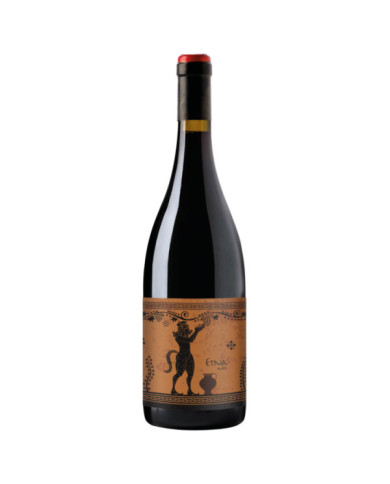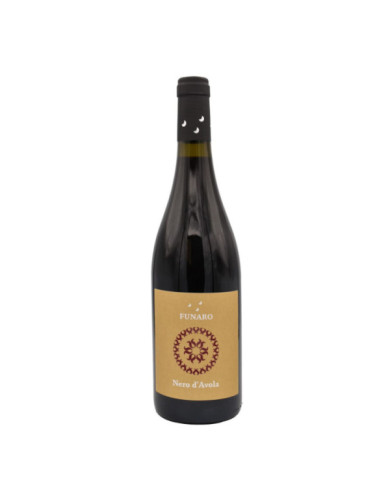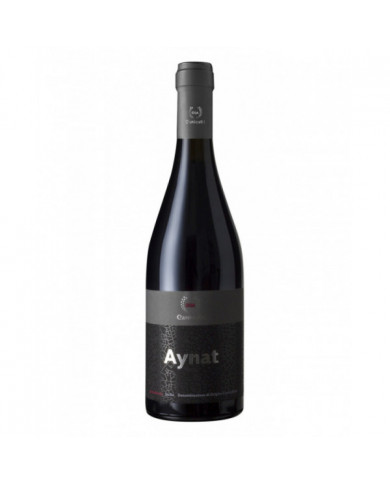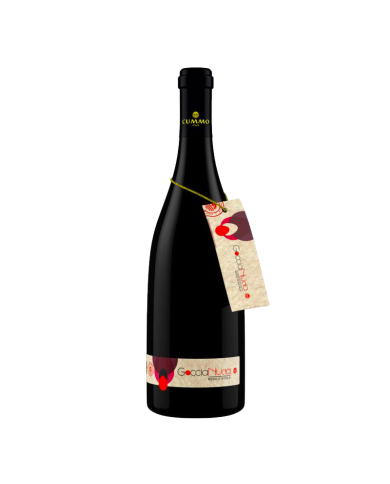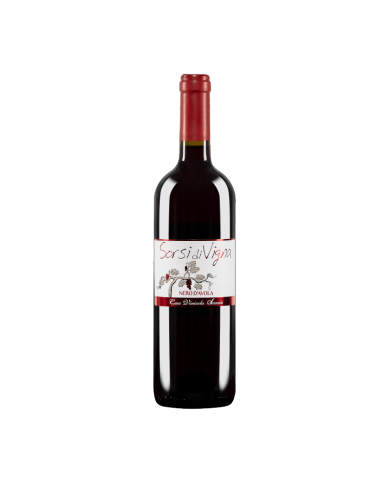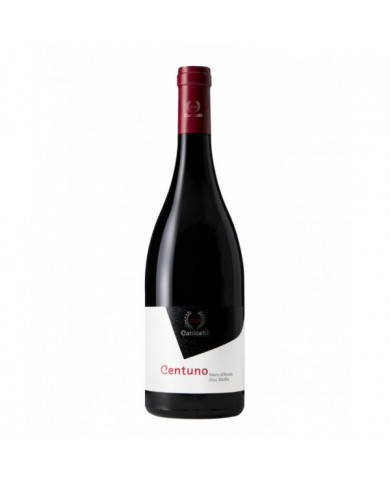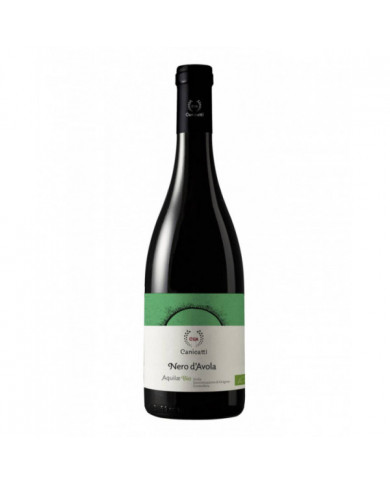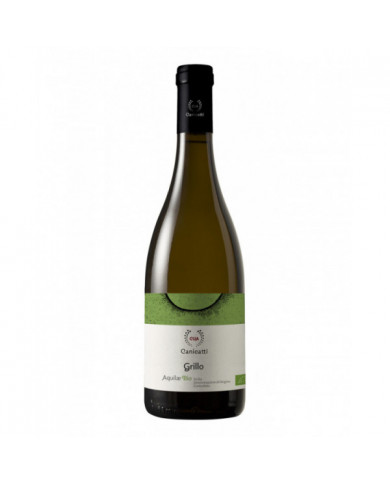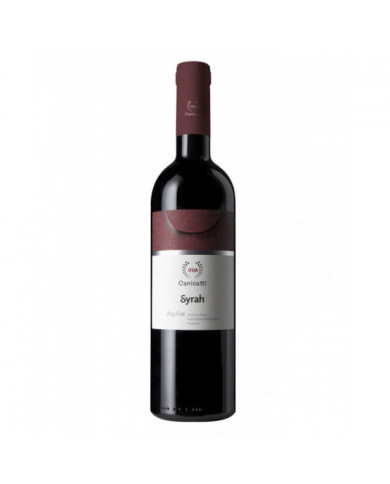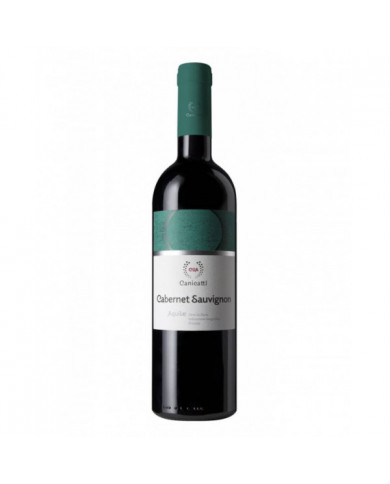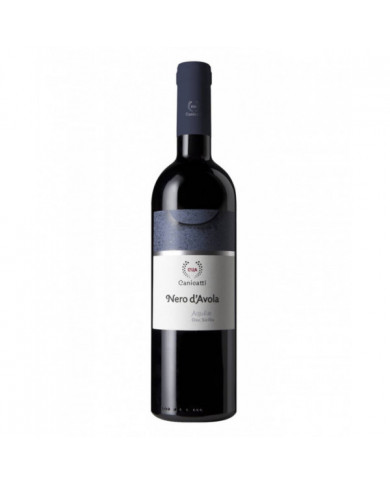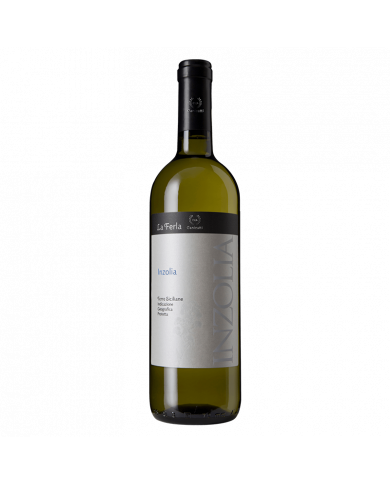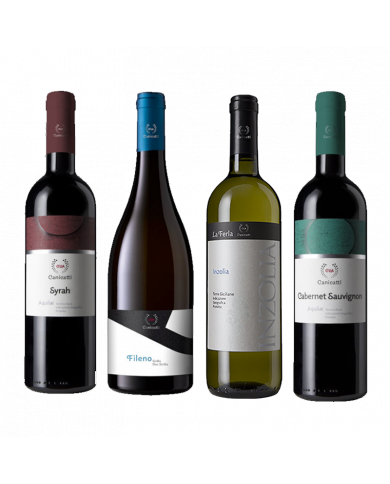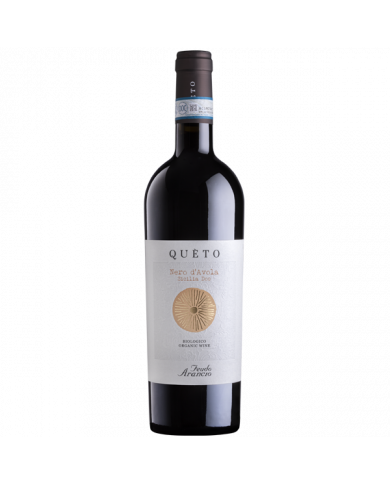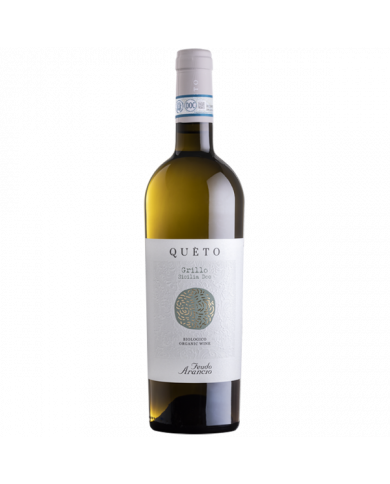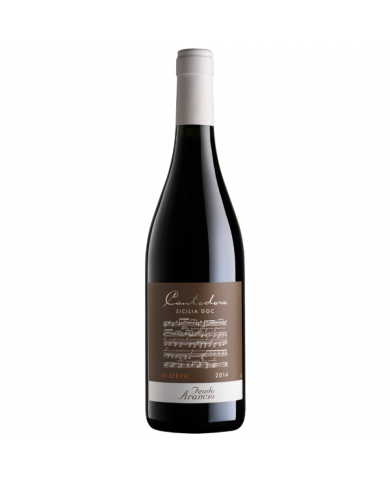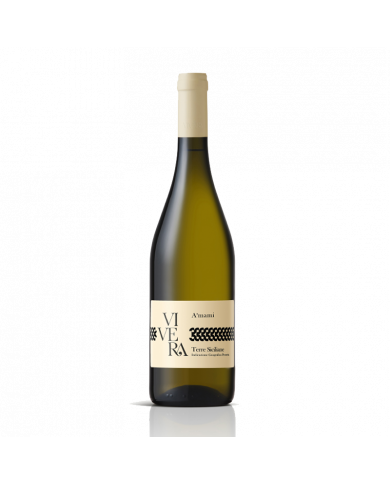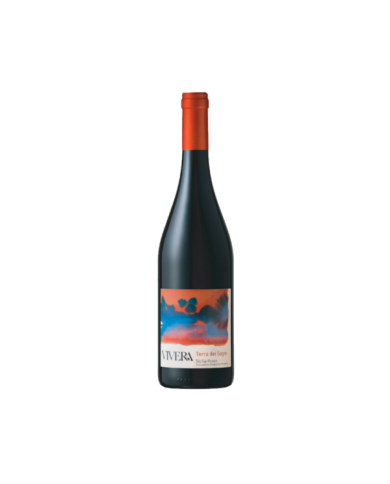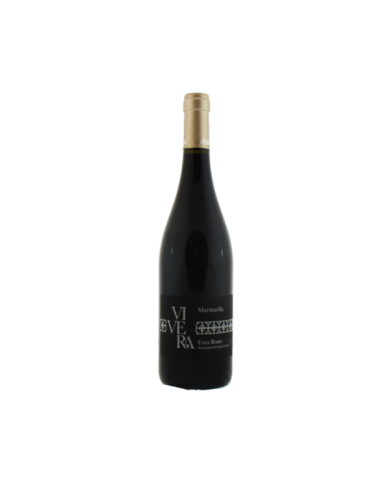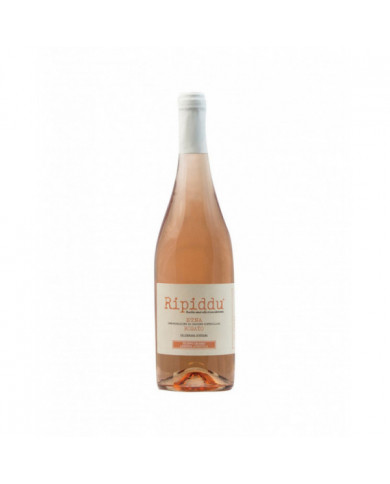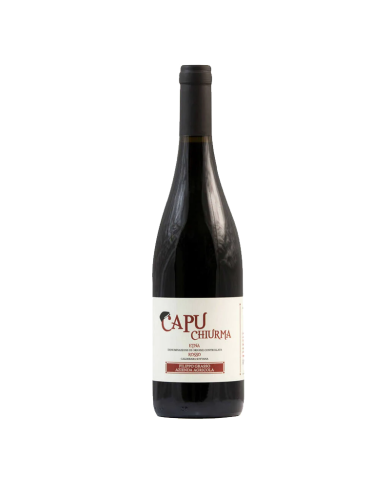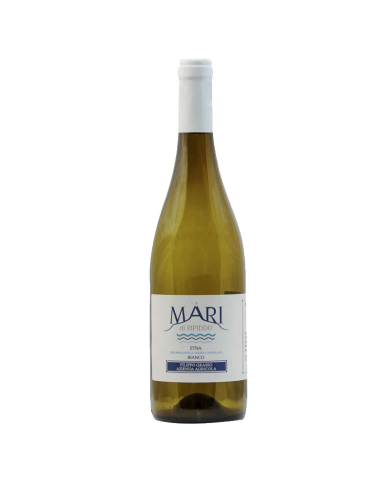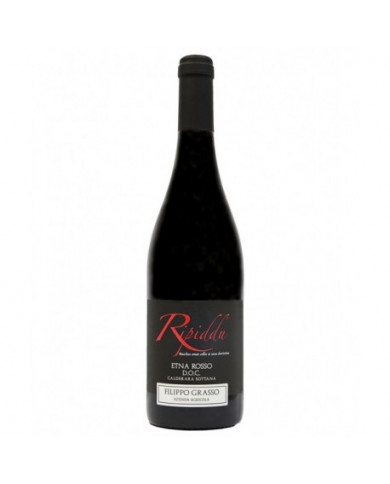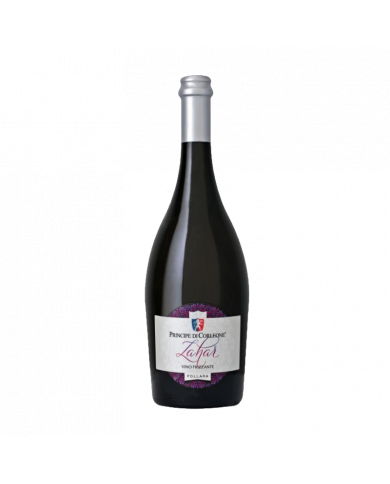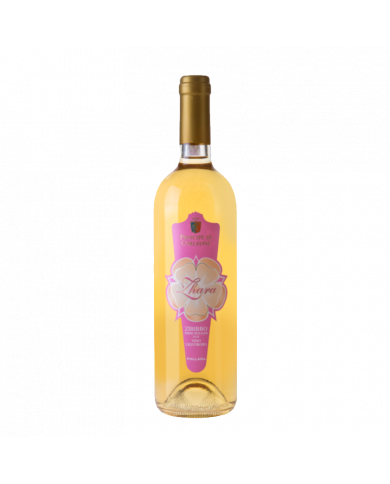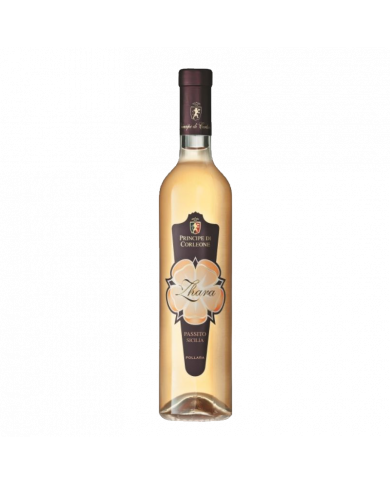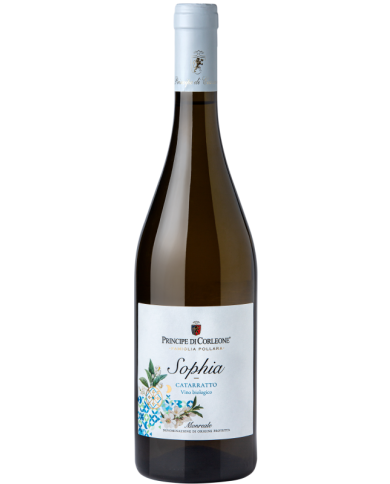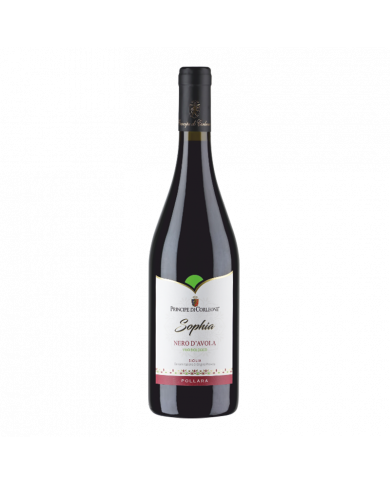Light ruby red, the nose expresses beautiful notes of pomegranate, cherry and currant. On the palate it is warm, full-bodied, harmonious and with excellent persistence. Throughout the meal, it is enhanced with medium-aged cheeses, with risotto with vegetables, quiches typical of the Sicilian tradition.
Characterized by an intense ruby red color typical of this vine. The nose offers delicate and persistent notes of red berries such as black currants, blueberries and cherries. Full, velvety and persistent, it aims at an elegant overall harmony.
It comes from one of the first vineyards planted. A Merlot that expresses all the potential and the character of this vine which is excellently expressed in the Sicilian terroire. Of great structure and power without lacking in great elegance. Vinification: in steel. Aging: in 50% new and 50% second passage barriques.
In the glass it shows a beautiful straw yellow color. The fruit, even exotic, is predominant on the nose, and combines with the hints of orange blossom typical of the zibibbo. It enters the mouth with a light sip, supported by a marked acidity that facilitates the flow of the drink, always balanced.
Excellent with a salmon chirashi.
RossoMandorla is the last born among the Martinez flavored products, the result of the union of two typical Sicilian flavours: Nero D'Avola wine and almonds. This combination gives life to a sweet dessert wine, with a deep red color typical of the vine of which it is a child, intense and persistent on the nose and in the mouth. In RossoMandorla the characteristic notes of Nero D'Avola wine, which are best expressed thanks to a long maceration process, are sweetened with the intense flavor of the aroma of bitter almonds. The processing is then completed with a small addition of alcohol.
Dedicated to grandmother Tanina, mother of 5 children, a generous and sweet woman but at the same time authoritative and decisive as Marsala La Madre presents itself: warm and enveloping in its amber colour, disruptive on the nose, sweet but never cloying in the mouth. In the Concia which is the phase in the production process in which the type of Marsala to be obtained is defined, the Mistella was added to the DOC base wine from Grillo grapes which gives it sweetness, cooked must and alcohol to then start the aging in oak barrels.
The Marsala Superiore Dolce bears the name of the Garibaldi because it is told both the type and the same preferred when he landed in Marsala to make the unification of Italy. With a residual sugar of 11%, it is the sweetest of the Marsala Martinez and probably for this reason it is the most loved by the female public. During the Concia which is the phase in the production process in which the type of Marsala to be obtained is defined, alcohol, Mistella and cooked must are added to the wine which gives it an intense amber colour. The aging process then begins in rivore barrels in which the wine is in contact with the air for many years, developing the characteristic oxidative bouquet.
The LAUS range contains three elite sweet liqueur wines, with persistent and intoxicating aromas, the result of a long production tradition that has always been oriented towards enhancing the flavors and aromas of the grapes left to ripen in the very hot Sicilian sun.
The Complice Grillo from the Vinanti Ragusa winery is a DOC Sicilia made from one of the grape varieties with the greatest interpretative declination. Born in Chiaramonte Gulfi from warm and calcareous soils, the Vinanti white wine goes perfectly with cheeses, seafood and baked fish.
Syrah Capofeto Sibiliana is a red wine with a complex and full-bodied taste that recalls the well-defined personality of the vineyards of Marsala (TP). Produced exclusively from Syrah grapes, it is a Terre Siciliane PGI rich in aromas and hints of the local terroir: a voluminous glass with a harmonious character.
It is the perfect glass for white wines with good structure and intensity; this type of wine certainly needs to "open up" (that is to better develop its aromatic, intense and complex endowment) and this is made possible by contact with oxygen (oxygenation) which, in fact, is facilitated by the generous dimensions of the chalice.
Gamma is a white wine of great finesse, dry and vertical as the Etna wines know how to be, long-lived, balanced in the play between acidity and body of the wine. It has a straw yellow color and an aroma of wild herbs and altitude flowers. --- Gamma: in physics, Gamma is the notation of the Lorenz factor, an equation that relates the dilation of time to the contraction of physical quantities, discovered at the time by Einstein. Wine makes people talk, unites people, expands the perception of time. Anyone who is passionate will experience the long chats around the emotional details that wine offers. Hours in which emotion and passion gracefully distort reality, transforming discussions around wine into pleasant journeys through history, culture and places, without moving from the table. Whenever wine is on the table, in the glass, it becomes a means for those who are passionate about it for long and passionate conversations. Culture, art, gastronomy mix with the evocation of the places where wine is produced, a virtual journey that extends for hours. Time and space confuse, wrap around flavors, colors and aromas, evoking emotions that come from often unknown lands.
Kudos is a white wine from an ancient, elegant and profound vineyard. Acidity and thickness played on the blade of the knife, to be drunk young or stored for years, according to his own inspiration
An incredible Nero d'Avola summer red, fruity and fresh. To be drunk young, vinified in steel tanks only, it manages to amaze with a delicate explosion of Mediterranean aromas. Ideal as an aperitif, it lends itself to any type of gastronomic combination. Pleasant even between meals.
Syrah Li Ciuri is a wine that originates in Western Sicily, in the immediate vicinity of Trapani. Obtained from 100% Syrah grapes, the bunches are harvested strictly by hand in the third week of August. The grapes, which arrive in the cellar, are subjected to the destemming process and then lightly pressed. This is followed by maceration at a controlled temperature; once fermentation is complete, the wine rests in steel vats until bottling and completes its maturation in the bottle.
The most famous among the native Sicilians. Intense ruby red in colour, the nose has notes of violets, cherries, plums and white pepper. On the palate it is medium-bodied, with soft tannins and delicate red fruits.
The only international variety among Curatolo Arini wines finds one of its maximum expressions in Sicily. Intense ruby red color with violet reflections, the nose offers notes of red fruits, plums, spices, black pepper and vanilla.
Born from the marriage between Nero D'Avola and Nerello Mascalese grapes, Satari is the ros├® of the Sicilian winery CVA Canicatt├¼ which stands out for its vivacity. The grapes are grown between 400 and 600 meters above sea level and undergo a first fermentation in steel tanks and a second fermentation in an autoclave. This ensures fine bubbles and enhances the aromatic bouquet of the grapes. Satari Rosato is a wine that brings the scents of Sicily into the glass to win you over with every sip and cheerfully accompany reunions with friends.
A Nero d'Avola of great harmony, our spearhead. Surprising in its aromas, precious for the elegance and silkiness of its tannins. An exciting wine.
A Nero d'Avola of great harmony, our spearhead. Surprising in its aromas, precious for the elegance and silkiness of its tannins. An exciting wine.
Nero d'Avola - DOC Sicilia with an intense red color with violet reflections and an intense, sunny, complex bouquet, from which hints of black cherry and red fruit emerge. Ideal if paired with cold cuts, meat first courses, roasts, game and soft, semi-mature, seasoned cheeses, salmon.
Intense ruby red color with violet reflections. Its perfumes are ethereal, aromatic, intense and fruity. On the palate it is harmonious, persistent, enveloping and rightly tannic.
CVA's Grillo Fileno is the best white wine in Italy
The highest score ever, among the Italian white wines offered for tasting at the Concours Mondial de Bruxelles 2022: Fileno, harvest 2021, Grillo in purity, is the best white wine in Italy. An extraordinary result for CVA, a small but prestigious wine cooperative in the Agrigento area.
A Nero d'Avola with intense and persistent aromas that can be discovered for its modernity and charm. A classy wine, which surprises for its harmony and pleasantness, capable of revealing the authentic traits of the prince of Sicilian natives.
A natural and authentically healthy wine that lets you capture the authentic essence and great harmony expressed by the main grape variety of the Sicilian natives.
An innovative white for flavor and freshness with the great versatility of an important vine of the Sicilian tradition; with clear and harmonious aromas. On the palate decisive, fruity, with an appropriate and pleasant acidity.
An innovative white for flavor and freshness with the great versatility of an important vine of the Sicilian tradition; with clear and harmonious aromas. On the palate decisive, fruity, with an appropriate and pleasant acidity.
Faithful to tradition yet modern and innovative. Inzolia in purity, a wine with its aromatic characteristics, which stands out for its savory and mineral taste.
Fileno, harvest 2021, 100% Grillo, is the best white wine in Italy. An extraordinary result for CVA, a small but prestigious wine cooperative in the Agrigento area.
From the vinification of Nero d'Avola and Nerello Mascalese grapes, a ros├® wine of great pleasure and fragrance takes shape. Intense in the aromas, elegant, savory and mineral on the palate.
Faithful to tradition yet modern and innovative. Inzolia in purity, a wine with its aromatic characteristics, which stands out for its savory and mineral taste.
Wine produced from organically grown Nero d'Avola grapes on the Sambuca di Sicilia estate, in the province of Agrigento. The vines are covered with grass and set on a gentle hill (300 meters slm ) which is particularly ventilated and characterized by clayey soils. The vineyard is located in the area of the company most exposed to winds and currents, so as to minimize the pressure of cryptogams.
Wine produced from grillo grapes grown organically on the Sambuca di Sicilia estate, in the province of Agrigento. The vineyard is grassed and grows on calcareous soils at about 200 meters slm in the shade of a wonderful tuff quarry, caressed by the winds that arrive from the nearby Mediterranean.
This wine, 100% Frappato, expresses the nobility and richness of one of the oldest Sicilian vines. Frappato is among the southernmost red berried varieties in Europe. Its historic enographic site is Vittoria, the youngest city in the Ragusa area lying in the lower Ibleo plain. This vine is suitable for the production of red wines with low coloring intensity, typical of a young red wine.
Nero d'Avola and Cabernet Sauvignon come together to give life to a wine that expresses the two souls of Sicily, a land of great native vines such as Nero D'Avola, but also a land that has happily welcomed international vines such as Cabernet Sauvignon. Nero d'Avola: grapes harvested around the second week of September, alcoholic fermentation with selected yeasts at 24-25┬░C for 14-16 days, malolactic fermentation with selected bacteria, maturation for 8 months in French barriques with 2 years aging and light toast. Cabernet Sauvignon: grapes harvested around the first week of October, fermentation and alcoholic maceration with selected yeasts at 26-28┬░C for 16-18 days, malolactic fermentation with selected bacteria, maturation for 12 months in French barriques with 3-year aging and medium roast. Blend: at the end of the maturation in wood, the Nero d'Avola and Cabernet wines are blended and further maturation of 4 months in barriques follows to favor the fusion of the aromas of the two different varieties. This is followed by bottling and subsequent maturation in the bottle for 8 months.
Variety of Middle Eastern origin which is best expressed in Sicily thanks to the intense luminosity and uniqueness of the soils. It is a medium-late variety, ripening around the end of September. The grapes are grown both in Sambuca di Sicilia, in the province of Agrigento, and in Acate, in the province of Ragusa. In the first estate, a more mature and structured wine is obtained, while in the second, a more delicate and fruity product is obtained. The type of training used is espalier, with an average planting density of 4,500 plants per hectare. Harvesting of the grapes at perfect phenolic ripeness, destemming and alcoholic fermentation with the skins for 10-12 days at 25-26┬░C, malolactic fermentation with selected bacteria, maturation for 10 months in French oak barriques.
Denomination Terre Siciliane PGI Ros├®
Grapes Merlot undefined Alcohol 13%
Format 0.75l
Serving temperature 12/14 ┬░C
Armida is a sensitive woman full of life, ingenious and funny. It fascinates by its audacity. Born in Corleone, she then moved to the Etna city. This wine symbolizes his character and his life. A'mami is a surprising and strong accord between the Carricante grapes of Etna and the Chardonnay grapes of the Corleone vineyards. The tension of Carricante meets the elegance of Chardonnay.
Ruby red wine with violet reflections. It has notes of red fruits, jam and sweet spices on the nose with a finish of vanilla and cocoa. In the mouth it is fresh, tannic and persistent Tagliatelle with ferla mushrooms, pasta with meat sauce, roast pork in milk with homemade bread croutons, grilled meat, walled octopus
Etna Rosso "Martinella" is a rich, intense and elegant wine that is born in the homonymous district at 600 m on the slopes of the volcano, aged for 30 months in old barriques. It has a deep but delicate bouquet of wild fruit in jam, spices, pepper and undergrowth. On the palate it is decisive, energetic and vigorous, with grace and gracefulness, with lively and soft tannins on the finish
Organic and Biodynamic Wine (Demeter) > Spontaneous fermentation > Natural tartaric stabilization
Ruby red with violet reflections, broad and persistent nose, full and harmonious in the mouth, it reflects the typicality of the old vineyards of Etna.
An elegant white, with well-marked mineral notes and a persistent and pleasant flavor on the palate. Excellent glass to combine, in order to be able to savor its exceptional qualities to the fullest, with seafood first courses, grilled roasted fish, shellfish and seafood appetizers.
Etna Rosso Ripiddu Filippo Grasso is produced from Nerello Mascalese and Nerello Mantellato grapes on the Etna volcanic soil and precisely on the North Slope of Etna, in the Randazzo area, in Contrada Calderara.
Carrico 68.8 is a "volcanic" wine from all points of view, produced on the northern slope of Etna and with an inimitable flavour. The soil composed almost exclusively of volcanic stones give the wine a unique minerality and flavour. The grapes, harvested during the first week of October, are then delicately pressed and then left to ferment at a controlled temperature. The nose offers a floral and fruity aroma with the prevalence of aromas of white pulp fruit. A wine with an Etna flavor and character that is always well appreciated by lovers of Sicilian wines. A white with well-marked mineral notes and a very pleasant sour taste on the palate. To be tried in combination with fish-based courses, seafood first courses and shellfish to be able to savor its exceptional qualities to the fullest.
It is a sparkling wine with excellent luminosity and a pale yellow colour. Fresh, pleasant, easy to drink, it is an interesting alternative to the classic sparkling wine. It is perfect for brightening up moments of conviviality.
From one of the most typical Sicilian vines and from the selection of the best zibibbo grapes ripened on the island in the warm African wind, this classic of great charm is born. Intense and aromatic, it has a complex and decisive aroma and its combination with spicy cheeses, once tried, is difficult to forget.
Produced from a careful selection of Moscato from Sicily, Lo Zhara Passito is an excellence thanks to a unique and inimitable relationship between sweetness and freshness. Harmonious, enveloping, perfect, it is a sweet wine capable of a very long aging in the bottle, the emotions are guaranteed after many years. The grapes, dried on racks, are pressed and left to macerate for about 5 hours, then they are softly pressed and fermented at 18-20┬░.
Elegant artistic bottle of Nero d'Avola ŌĆō Principe di Corleone. The bottle is entirely handmade by decorator artists and engravers, who model the surface of the bottle with skill and passion, making it unique.
Obtained from Catarratto grapes from organic farming, it has a straw yellow color with greenish reflections. Ample bouquet with hints of white flowers and a strong, full and harmonious flavour. Ideal with all dishes based on fish, shellfish and soft cheeses.
Obtained from Nero d'Avola grapes from organic farming, it has a ruby red colour. Fruity aroma with delicate hints of peanuts and almonds and a full-bodied flavor with a concentration of gentle tannins. It elegantly accompanies all types of dishes. Ideal with medium texture cheeses.
From the precious Nerello Mascalese grapes comes this Classic Method Spumante which, refermented in the bottle, continues to maintain and refine for several years, thus acquiring a delicate and complex aroma and a subtle and persistent perlage.
The San Lo├© Classic Method Spumante is perfect to accompany menus based on raw fish and more generally seafood dinners.
Straw yellow in color with greenish reflections, it has a very fruity aroma, dominated by a clear aromatic note. The flavor is delicate, light, harmonious, pleasantly aromatic. Perfect as an aperitif, it goes well with appetizers, first courses and fish with sweet meat. To be drunk young at a temperature of 8┬░ - 10┬░C.
It reinterprets one of the most widespread grape varieties in the Mediterranean in a modern key. Terre Siciliane Syrah IGT wants to be, in the name, a tribute to the warm southeast wind of the ancient city of Syracuse, it is a full-bodied wine of great consistency, enveloping and palpitating.
A great Sicilian classic that represents one of the historic vines of Sicily. A Nero d'Avola of rare elegance that stands out. Ruby red in color with violet reflections, it has an intense and fragrant aroma. The taste is fine and elegant, warm, dry, full-bodied.
Among the first pure Cabernet Sauvignon produced in Sicily. For his personality and originality he has been awarded many times over the years. Expresses the territory from which it comes: Corleone. With a purplish-red colour, it has a complex and persistent aroma, reminiscent of blackcurrant fruits and spices.
Quercus Nero d'Avola Dop Sicilia is the most important Nero d'Avola of the Pollara family. It ages for 24 months in Allier and Never oak barriques. It expresses elegance, power, balance. It enhances the unique scents of the lands of Sicily.
Typical olfactory profile outlined by the magmatic and balsamic traits of the territory within which the varietal notes of Mediterranean scrub are expressed, rich in berries and wild aromatic herbs, blueberries and cassis, embellished with fine spiciness.
Nerobaronj is characterized by an intense ruby red color with violet reflections. On the nose, aromas of ripe red fruit can be perceived, such as cherry and plum, combined with spicy and slightly herbaceous notes. In the mouth it is a very structured wine, with well-present but balanced tannins and a fresh and vibrant acidity. The finish is long and persistent, with hints of fruit and spices that come together in a pleasant harmony.
Discover the secrets of Sicilian wines: A journey through the winemaking tradition of Southern Italy
Sicily is one of the richest regions of Italy both for its history and for its winemaking tradition. Sicilian wines are among the most appreciated in the world and are famous for their quality. In this article we will discover what the secrets of these delicacies are and how to enjoy them to the fullest.
Sicilian Wines: An ancient and rich history
The tradition of wine production in Sicily dates back to the Greco-Roman period, when the island was rich in native varieties. Over the centuries, the production of Sicilian wines has remained at the heart of the region's culture and economy. Today, Sicilian wines are famous all over the world for their unique quality.
Sicilian wines: variety and characteristics
There are numerous varieties of Sicilian wines. The most famous are Nero d'Avola, Nerello Mascalese, Frappato and Grecanico. These wines are characterized by a great aromatic complexity: hints of red fruits, spices, flowers and vanilla. Nero d'Avola is an intense, full-bodied red wine, while Nerello Mascalese is lighter and fruitier. Frappato is a light and aromatic ros├® wine, while Grecanico is a fresh and fruity white wine.
How to choose the right wine
Choosing the right wine comes down to personal preferences and the occasion. For example, if you want to drink a high quality red wine, then you should opt for a Nero d'Avola. If you want a lighter and fruitier wine, you can choose a Nerello Mascalese. For a white wine, Grecanico is a great choice.
How to serve a Sicilian wine
To enjoy a Sicilian wine to the fullest, it must be served at a temperature of 18-20┬░C. It is advisable to serve red wines in fairly large glasses, with a wider base and a narrower top. White wines, on the other hand, are served in smaller glasses with a narrower base and wider top.
The right combination
Each wine has its own ideal pairing. For example, Nero d'Avola is a very versatile wine and goes well with meat-based dishes, such as grilled steak for example. Nerello Mascalese, on the other hand, goes best with fish or vegetable dishes. Frappato is a wine that goes well with lighter dishes, such as a mixed salad. Grecanico is a wine that goes well with fish or vegetable dishes.
5 tips for Sicilian wines
1. Choose a quality wine. Sicily is full of excellent quality wines, so choose a product from a reliable producer.
2. Taste more wines. Taste multiple Sicilian wines to find out which one you like best.
3. Store wine well. Store Sicilian wines in a cool, dry place away from heat sources.
4. Choose a right match. Pair Sicilian wines with the right dishes to get a unique taste experience.
5. Don't be shy. Don't hesitate to drink Sicilian wine and experiment with new varieties.
Discovering the secrets of Sicilian wines is a unique experience. Sicily is one of the richest regions of Italy and Sicilian wines are among the finest in the world. In this article we have explored the history of these wines, their characteristics, how to choose and serve a Sicilian wine and how to pair it with the right dishes. By following these tips you will be able to enjoy these delicacies to the fullest and discover the secrets of Sicilian wines.
Denomination Wines of Sicily
Sicily is a region famous all over the world for its wine production. Thanks to the Mediterranean climate, the presence of volcanoes and the richness of the soil, the island is able to produce some of the most appreciated wines in the world. In this article we will explore the main denominations of Sicilian wines, their vines and their organoleptic characteristics, to discover the excellence of Sicilian wine production.
Introduction to wine production in Sicily
The production of wine in Sicily has very ancient roots, dating back to Greek and Roman times. The region boasts a great variety of soils, from the volcanoes of Etna and the Aeolian Islands to the hills of the hinterland, which allow for the cultivation of numerous native and international vines. Thanks to the use of innovative techniques and attention to quality, Sicilian wine production is constantly growing, offering the market high quality wines, capable of satisfying every palate.
The main denominations of Sicilian wines
The denominations of wines of Sicily are divided into four main categories: Denomination of Controlled Origin (DOC), Denomination of Controlled and Guaranteed Origin (DOCG), Typical Geographical Indication (IGT) and Table Wines. Let's see in detail the characteristics of each one.
Denomination of Controlled Origin (DOC)
The denomination of controlled origin (DOC) is a quality mark that is assigned to wines that meet specific production criteria. In Sicily there are 23 DOCs, among which Cerasuolo di Vittoria, Moscato di Pantelleria and Etna Rosso stand out.
Cerasuolo di Vittoria
Cerasuolo di Vittoria is a red wine produced in the south-eastern part of the island, in the province of Ragusa. The wine is produced with grapes from the Nero d'Avola and Frappato vine, in variable percentages, and has an intense ruby red colour, a fruity aroma and a dry and soft flavour. It goes perfectly with red meats, cured meats and aged cheeses.
Muscat of Pantelleria
Moscato di Pantelleria is a sweet wine produced on the island of Pantelleria, located southwest of Sicily. The wine is produced with grapes from the Moscato di Alessandria vine, locally called Zibibbo, and has an intense golden yellow colour, an intense and aromatic bouquet and a sweet and soft flavour. It goes perfectly with sweets and desserts.
Etna Red
Etna Rosso is a red wine produced on the slopes of Etna, the highest active volcano in Europe. This wine is mainly produced with grapes from the native Nerello Mascalese vine, which grows on volcanic and high altitude soils.
What is Sicily's most famous wine?
A: Sicily's most famous wine is Etna Rosso, a red wine produced on the slopes of Etna.
Denomination of Controlled and Guaranteed Origin (DOCG)
The denomination of controlled and guaranteed origin (DOCG) is the maximum expression of the quality of Italian wines. In Sicily there is only one DOCG, the Cerasuolo di Vittoria. This dry red wine is produced in the Vittoria area, in the province of Ragusa, with grapes of the Nero d'Avola and Frappato vine in variable percentages. The wine has a ruby red colour, a fruity aroma and a soft and persistent flavour. It goes perfectly with red meats, cured meats and aged cheeses.
Typical Geographical Indication (IGT)
The Typical Geographical Indication (IGT) identifies wines produced in a specific geographical area and which have some typical characteristics. In Sicily there are four IGTs: Terre Siciliane, Salina, Val di Mazara and Alcamo. IGT wines can be produced with international grape varieties, such as Chardonnay, Cabernet Sauvignon and Merlot, but also with native varieties.
Table wines
Table wines are wines produced in Sicily that do not fall into the DOC, DOCG or IGT categories. Despite this, many of them are of the highest quality, produced with native grapes and according to traditional methods. Among the best known are Nero d'Avola and Grillo.
Sicily is a region with a great winemaking tradition, which has been appreciated all over the world for the quality of its wines. Thanks to the presence of volcanoes, the Mediterranean climate and the variety of the terrain, the island is able to produce wines of the highest quality, capable of satisfying every palate. From DOC to IGT, from white wines to red wines, Sicilian wine production is a real winemaking excellence.
FAQs
What are the native vines of Sicily?
Among the main native vines of Sicily are Nero d'Avola, Frappato, Inzolia, Grillo and Zibibbo.
How many DOC wines are there in Sicily?
In Sicily there are 23 DOC wines.
What are the main pairings of Sicilian wines?
The red wines of Sicily go perfectly with red meats, cured meats and aged cheeses, while the white wines are ideal with fish dishes, seafood and fresh cheeses.
What is the difference between DOC and DOCG?
The main difference between DOC and DOCG is that DOCG guarantees a superior quality of wine, with even stricter production criteria and more frequent controls.
What are the best known wines of Sicily?
Among the best known wines of Sicily are Etna Rosso, Cerasuolo di Vittoria, Nero d'Avola and Grillo.

